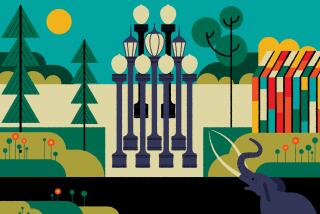The Locks Are the Key
- Share via
Nicole Watson’s hairstyle of intricately looped long braids looks regal on the 18-year-old. That was by design, says hairstylist Cheryl Alleyne, who described her creation of “inverted cornrows” as “goddess braids.”
Watson was one of the models from Imani Jordan Hair Studio who showed off modern interpretations of traditional African styles currently on display at the California African American Museum’s “Hair in African Art and Culture.” Another model sported Senegalese twists--braids of two strands instead of the traditional three.
They demonstrated current looks and techniques to hair aficionados, braiders and families who filled the museum’s special events corner last Sunday for the workshop “Fantastic Hair!”
The session provided a fun connection between contemporary hairstyles--cornrows have now crossed over to mainstream--and the enduring influence of African styles. For example, seeing the Nigerian Cross River crest mask with its elaborate coif in the exhibit brings to mind Watson’s hair. Pictures of 1990s New Yorkers wearing dreads that look similar to tribal hairstyles adorn the museum’s walls.
Hair in Africa through the years, and depending on the region, telegraphs different messages such as social status, religion, gender and mourning, according to Roy Sieber of New York’s Museum for African Art and the exhibition’s co-curator.
Stateside hair today is mostly about aesthetics, though the American Afro of the 1960s was as much a political statement as it was about style. Nawili Gray, a hair braider of 30 years, has seen styles evolve from the large braids decorated with jade or crystals in the 1970s to hair extensions and tiny tight braids in the 1990s.
Gray demonstrated hair wrapping techniques, nimbly coiling white yarn around strands of Luis Dixon’s short hair. Dixon, 53, waited patiently as Gray worked on his head, beginning at the scalp. He ended up with a “scalp wrap” of three white twists--one on top and one on each side.
“I like it when a woman messes with my hair,” Dixon said. “It creates both a spiritual and aesthetic experience.” But getting his hair done also gave him a sense of confidence, he said.
“I’ve been raised in a society where hair has always been a big issue,” he said. “I just decided one day that I wanted to turn my life over to a higher source--and to do that meant letting go of control of my hair.”
The rich traditions of African braiding are not lost on young girls, teens and younger who assisted in the demonstrations. “It’s something I enjoy,” said Taaz Brown, 16, who is learning the craft in a “Young Images Arising” program offered by the L.A.-based company Institute of Fine Braidery Arts.
“I can show my creative style,” she added as she braided extensions into Kiarra Elliott’s hair. Brown herself favors cornrows.
The exhibit, which continues through Aug. 19, highlights more than 170 artifacts such as elaborate combs, wigs, head masks, statues and black-and-white tribal photographs that document hair in Africa and America.
The show includes an authentic, modern-day barber shop brought from Ghana that is decorated with American sayings such as “time is money” and “sporting waves.”
“I’m glad that people can identify with the [African] culture,” hair braider Gray said. “But at the same time it’s great to have your own expression. You don’t have to look like everybody else.”
*
Two more workshops at the museum are scheduled Saturday on head wrapping and hat making. 1-3 p.m. Admission free. Parking $5. 600 State Drive, Los Angeles. (213) 744-7432.
More to Read
The biggest entertainment stories
Get our big stories about Hollywood, film, television, music, arts, culture and more right in your inbox as soon as they publish.
You may occasionally receive promotional content from the Los Angeles Times.










